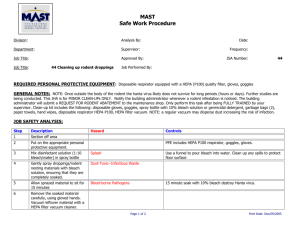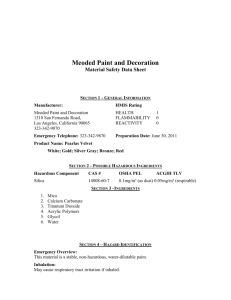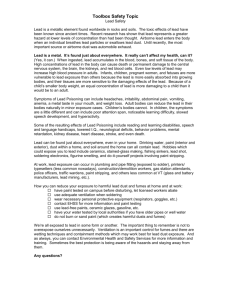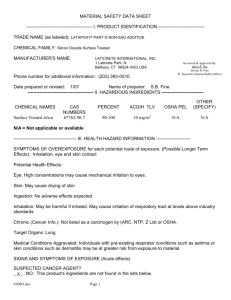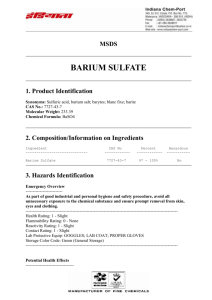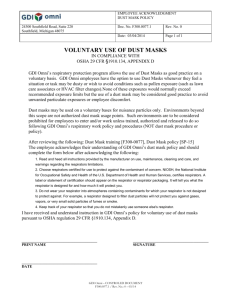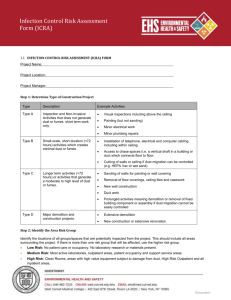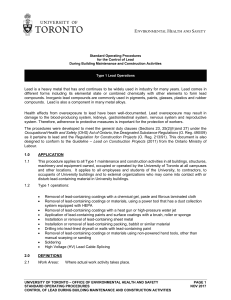Exposure Control Plan for the Removal of Lead
advertisement
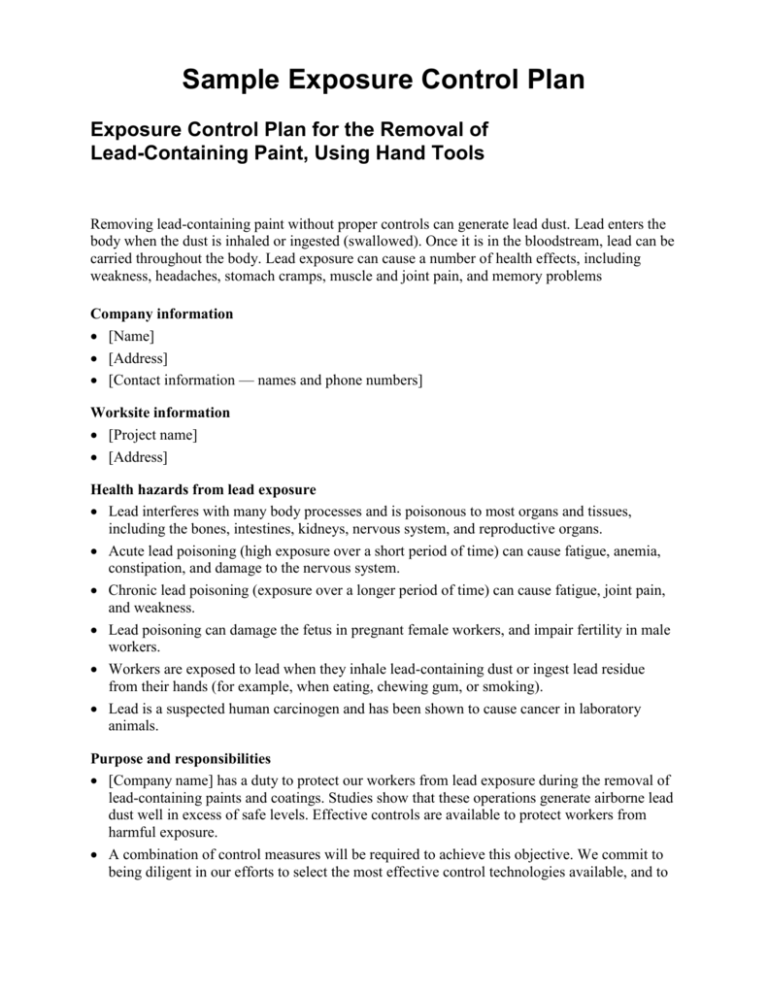
Sample Exposure Control Plan Exposure Control Plan for the Removal of Lead-Containing Paint, Using Hand Tools Removing lead-containing paint without proper controls can generate lead dust. Lead enters the body when the dust is inhaled or ingested (swallowed). Once it is in the bloodstream, lead can be carried throughout the body. Lead exposure can cause a number of health effects, including weakness, headaches, stomach cramps, muscle and joint pain, and memory problems Company information [Name] [Address] [Contact information — names and phone numbers] Worksite information [Project name] [Address] Health hazards from lead exposure Lead interferes with many body processes and is poisonous to most organs and tissues, including the bones, intestines, kidneys, nervous system, and reproductive organs. Acute lead poisoning (high exposure over a short period of time) can cause fatigue, anemia, constipation, and damage to the nervous system. Chronic lead poisoning (exposure over a longer period of time) can cause fatigue, joint pain, and weakness. Lead poisoning can damage the fetus in pregnant female workers, and impair fertility in male workers. Workers are exposed to lead when they inhale lead-containing dust or ingest lead residue from their hands (for example, when eating, chewing gum, or smoking). Lead is a suspected human carcinogen and has been shown to cause cancer in laboratory animals. Purpose and responsibilities [Company name] has a duty to protect our workers from lead exposure during the removal of lead-containing paints and coatings. Studies show that these operations generate airborne lead dust well in excess of safe levels. Effective controls are available to protect workers from harmful exposure. A combination of control measures will be required to achieve this objective. We commit to being diligent in our efforts to select the most effective control technologies available, and to ensure that the best practices, as described in this exposure control plan (ECP), are followed at our worksites. The work procedures we establish will protect not only our workers but also any other workers on-site who are not involved in these operations. The employer is responsible for the following: Ensuring that the materials (for example, tools, equipment, personal protective equipment [PPE]), and other resources (for example, worker training) are readily available to fully implement and maintain this ECP. Ensuring that supervisors and workers are educated in the hazards of lead exposure, and trained to work safely during the removal of lead-containing paints and coatings. Ensuring that workers follow the requirements of the Occupational Health and Safety Regulation and the Workers Compensation Act. Maintaining written records of training (for example, proper use of respirators), fit-test results, crew talks, and inspections (for example, of equipment). Conducting an annual review (or more often if conditions change) of the effectiveness of the ECP. This includes a review of available control technologies to ensure that these are selected and used when practicable. Coordinating work with the prime contractor and other employers to ensure a safe work environment. Initiating immediate investigations into incidents/accidents and reporting these to WorkSafeBC. Supervisors are responsible for the following: Providing adequate instruction to workers on the hazards of lead exposure. Selecting and implementing the appropriate control measures. Ensuring that workers using respirators have been properly trained and fit-tested, and that the results are recorded. Ensuring that work is conducted in a manner that minimizes and adequately controls the risk to workers and others. This includes ensuring that workers use appropriate engineering controls and wear the necessary PPE. Immediately correcting unsafe acts and conditions. Workers are responsible for the following: Participating in all required health and safety education and training. Using the assigned protective equipment in an effective and safe manner. Following established work procedures as directed by the supervisor. Reporting any unsafe conditions or acts to the supervisor. Reporting to the employer any exposure incidents or any signs or symptoms of lead illness. Exposure Control Plan for the Removal of Lead-Containing Paint, Using Hand Tools 2 Hazard identification and risk assessment Lead-containing paints can contain anywhere from 0.009% to 50% lead by weight. Studies have shown that removal of paint with a lead content as low as 0.06% can generate airborne concentrations of lead that approach the occupational exposure limit. Removing lead-containing paint without the use of proper controls and PPE can expose workers to levels of airborne lead dust that are above the exposure limit listed in the Regulation. Unprotected workers or other persons may be exposed to the hazards of lead. All lead work locations will be enclosed by barriers or barrier tape and identified with signs or placards. Exposure limit The occupational exposure limit (OEL) for inorganic lead is 0.05 milligrams per cubic metre (mg/m3). Because lead is a suspected human carcinogen and linked with cancer in animals, workplace exposures must be reduced to levels that are As Low As Reasonably Achievable (ALARA) below the OEL. Lead dust controls The Regulation requires employers to select lead dust controls based on the following hierarchy: 1. Engineering controls (for example, barriers, enclosures, general ventilation, local exhaust ventilation) 2. Administrative controls (for example, wash stations, separate eating and changing areas, and limiting the time workers are exposed to lead) 3. Personal protective equipment (such as respirators and disposable coveralls) Respirators will be used in conjunction with other controls to reduce worker exposure to lead, unless air monitoring information suggests otherwise. A HEPA vacuum will be used for cleanup and decontamination. Acceptable control methods for removing lead-containing paint The work methods in the following table are acceptable, provided that the respirator selection, dust suppression, and other controls are adhered to. The following control options will be used to eliminate or reduce the risk to workers from the hazards of lead dust exposure, unless air monitoring information suggests otherwise. Exposure Control Plan for the Removal of Lead-Containing Paint, Using Hand Tools 3 Work activity Dust suppression Other controls Respirator type Manual (hand) sanding or scraping Peeling paint will be misted with water before scraping. Debris will be misted before sweeping or vacuuming. A HEPA vacuum will be used to remove debris. Disposable drop sheets will be placed below the work area. Barriers (for example, a tape barrier) will be installed to restrict access to the work area. Signs will be posted at every entrance to the work area. Workers will use disposable coveralls. NIOSH-approved single-use N95, N99, or P100 respirator Half-face respirator with HEPA P100 series filters Manual scraping The heat gun Disposable drop sheets will be using heat guns temperature must be kept placed below the work area. as low as practicable. Barriers (for example, a tape barrier) will be installed to restrict Debris will be misted before sweeping or access to the work area. vacuuming. Partial or full enclosures will be constructed around work areas A HEPA vacuum will be where significant removal will take used to remove debris. place. Where full enclosures are required, they will be equipped with HEPAfiltered mechanical ventilation. Signs will be posted at every entrance to the work area. Workers will use disposable coveralls. Half-face respirator with HEPA P100 series filters Manual scraping Debris will be misted Disposable drop sheets will be using a chemical before sweeping or placed below the work area. stripper vacuuming. Barriers (for example, a tape barrier) will be installed to restrict A HEPA vacuum will be used to remove debris. access to the work area. Signs will be posted at every entrance to the work area. The work area will be ventilated with a continuous supply of fresh air for the workers. continued on next page Half-face respirator with HEPA P100 series/organic vapour cartridges Additional respiratory protection may be required as recommended by the MSDS for the chemical stripper Exposure Control Plan for the Removal of Lead-Containing Paint, Using Hand Tools 4 Work activity Dust suppression Other controls Respirator type Partial or full enclosures will be constructed around work areas where significant removal will take place. Where full enclosures are required, they will be equipped with HEPAfiltered mechanical ventilation. Workers will use disposable coveralls. Methylene chloride products will not be used. Additional PPE (for example, gloves and goggles) may be required as recommended by the MSDS for the chemical stripper. Removing paint using powered hand tools Tools equipped with a HEPA-filtered dust collection system will be used. Debris will be misted before sweeping or vacuuming. A HEPA vacuum will be used to remove debris. Disposable drop sheets will be placed below the work area. Barriers (for example, a tape barrier) will be installed to restrict access to the work area. Signs will be posted at every entrance to the work area. Workers will use disposable coveralls. Tools without a dust Disposable drop sheets will be suppression system will placed below the work area. be used. Partial or full enclosures should be constructed around work areas Debris will be misted before sweeping or where removal will take place. vacuuming. Where full enclosures are required, they should be equipped with A HEPA vacuum will be HEPA-filtered mechanical used to remove debris. ventilation. Workers will use disposable coveralls. Exposure Control Plan for the Removal of Lead-Containing Paint, Using Hand Tools NIOSH-approved single-use N95, N99, or P100 respirator Half-face respirator with HEPA P100 series filters Full-face elastomeric respirator equipped with P100 HEPA cartridges, or Powered airpurifying respirator (PAPR) equipped with P100 HEPA cartridges 5 Safe work planning Select one or more of the methods described in the table on pages 62 and 63. Establish a barrier or full enclosure around the work zone to restrict access by unprotected workers (full enclosures may require negative-pressure ventilation through a HEPA filter). Inspect all dust control equipment and tools to make sure they are in good working order. Use and maintain all tools and equipment as specified by the manufacturer. For example, test the effectiveness of HEPA filters using dioctyl phthalate (DOP) testing or similar means at least annually, and any time a HEPA filter is replaced in a vacuum cleaner or ventilation system. When working on a multiple-employer site, provide the general contractor with a copy of the lead exposure control plan and safe work procedures. Review the procedures and work schedule with the general contractor to determine whether additional measures are required to reduce worker exposure to lead. Ensure that workers inspect their respirators before start-up. Respiratory protective equipment Each worker will be fit-tested if a respirator is required. If a worker is required to wear a respirator that requires an effective seal with the face for proper functioning, the worker must be clean-shaven where the respirator seals with the face. When the worker notices a notable resistance to breathing, the respirator filters must be replaced. Respirators will be used, cleaned, and stored in accordance with the respiratory protection program. Other personal protective equipment and hygiene Workers should change from street clothes to work clothes (including footwear) at the beginning of their work shift. Street clothes should be kept separate from work clothes. Washing (and shower, if required) facilities should be located between “clean” changing areas and “dirty” work areas. Workers should remove contaminated outer work clothing and thoroughly wash their hands and faces before eating, drinking, or smoking. No eating, drinking, smoking, chewing gum, or nail biting should be allowed in the work area. No food, gum, cigarettes, or other personal items should be stored in the work area. Coffee and lunch breaks should be taken in a clean area separate from the work area. Workers should remove all work clothes and shoes at the end of the work day and leave them at work. Workers should wash (or shower) before leaving work to ensure that any potential contamination is removed before they go home. Workers should not take any contaminated items home, as this may expose family members to lead. Exposure Control Plan for the Removal of Lead-Containing Paint, Using Hand Tools 6 Housekeeping procedures Dry sweeping and the use of compressed air are prohibited for removing dust and debris containing lead. Work areas and equipment covered by dust will be cleaned at the end of every shift using a HEPA-filtered vacuum. Wet cleanup may also be used to remove dust. Waste material will be placed in a dumpster, and will be removed at least weekly. The location and method used to store waste will not allow lead-containing dust to re-enter the workplace. Supervisors are responsible for ensuring that work areas are free from dust at the end of each shift. Worker training for lead exposure Training will be performed by the employer or the employer’s designate. Records of attendance, dates of training, and training material will be documented and retained. Additional training or reference material on lead exposure will be made available to employees upon request. Training topics: o Health hazards of lead exposure o Engineering controls and safe work practices used to protect workers o The importance of proper equipment control and maintenance o Housekeeping procedures o Proper use of respirators and the respirator program o Personal hygiene procedures to reduce exposures o The details of the exposure control program for lead Health surveillance A health monitoring program (including the collection and analysis of blood samples) will be implemented, under the supervision of an occupational physician, for projects more than one week in duration. Annual review This ECP will be reviewed at least annually and updated as necessary by the employer, in consultation with the workplace health and safety committee or the worker health and safety representative. Exposure Control Plan for the Removal of Lead-Containing Paint, Using Hand Tools 7
